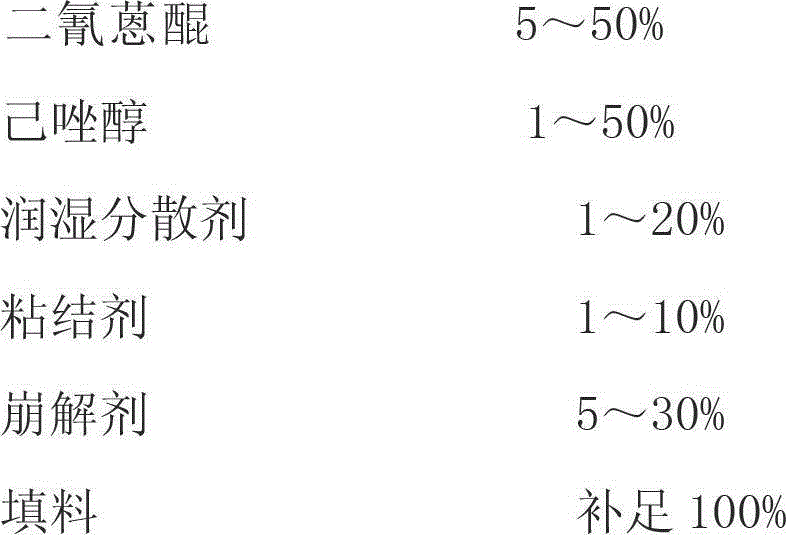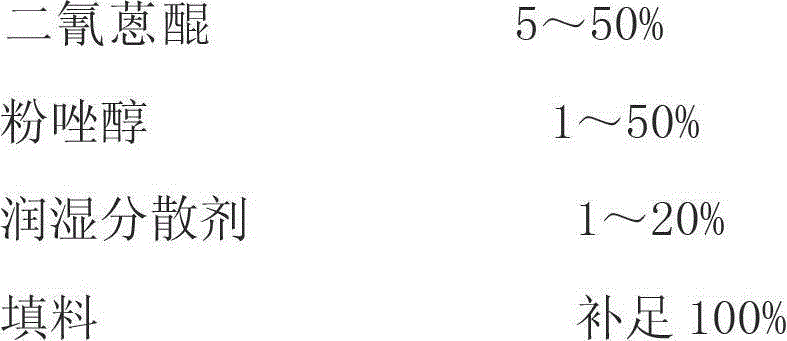Agricultural sterilization compound composition containing dithianon
A compound composition, the technology of dicyananthraquinone is applied in the directions of fungicides, biocides, applications, etc., which can solve the problems of serious environmental pollution and large dosage, and achieves reduction of environmental pollution, adverse effects, and expansion of sterilization spectrum. Effect
- Summary
- Abstract
- Description
- Claims
- Application Information
AI Technical Summary
Problems solved by technology
Method used
Image
Examples
example 1
[0054] Example 1 Indoor toxicity test for apple tree rot
[0055] Subject: Apple tree rot
[0056] Test method: Refer to "People's Republic of China Agricultural Industry Standard NY / T1156.2-2006". First, set 5 different concentration gradients for the single agent and each mixed agent (based on the results of preliminary experiments, according to different combinations and ratios of different agents, the concentration gradient settings are also different, and the antibacterial rate is 5%-90 Within the range of %, it is set by the proportional series). Cool the melted PDA medium to 60-70°C, add quantitative drugs according to the designed amount to prepare poisonous medium with different amounts of drugs, repeat 3 times, after it is fully cooled, inoculate apples with a diameter of 0.5 cm Put the decayed pathogen pieces in an incubator (temperature 25℃±1℃) for 5 days to investigate, measure the growth diameter of the colony of each treatment, and calculate the inhibition rate, by...
example 2
[0073] Example 2 Indoor virulence determination of rice blast fungus
[0074] Test object: Magnaporthe grisea collected from the field
[0075] Test method: refer to "The People's Republic of China Agricultural Industry Standard NY / T1154.7-2006", potting method. Select rice seedlings at the three-leaf stage with the same growth potential, 2 seedlings per pot, and 5 pots for test rice seedlings for each treatment. The rice blast fungus was cultured on tomato oat agar medium. After sporulation, the spores were washed with sterile water to make a suspension of 1×105 spores / mL, and sprayed evenly on the test rice seedlings. Put on a black plastic bag and incubate for 24 hours. After 24 hours of inoculation, the agent was treated with 5 concentration gradients for each agent, and sprayed with a Potter spray tower at a pressure of 50 PSI, about 5 mL per pot. After spraying, the rice seedlings were cultured at about 25°C and relative humidity ≥90%. After 7 days, the disease index of th...
example 3
[0092] Example 3 Indoor virulence determination of rice sheath blight
[0093] Test object: Rhizoctonia solani from the field
[0094] Test method: Refer to "People's Republic of China Agricultural Industry Standard NY / T1154.7-2006", broad bean separated leaf method. The rice sheath blight fungus was cultured with PDA medium, and when the colony had just overgrown the petri dish, punched holes from the edge with a punch with an inner diameter of 5 mm, and the punched hyphae block was used as an inoculum. Select broad bean leaves with the same leaf position, immerse them in the configured chemical solution for 10 minutes for each treatment, take them out to dry, and put them in a petri dish covered with moisturizing paper. Each chemical has 5 concentration gradients. Finally, the mycelium block was connected upside down to the center of the leaf and cultured in a constant temperature incubator at 28°C. After the control is fully onset, the diameter of the lesion is measured by the...
PUM
 Login to View More
Login to View More Abstract
Description
Claims
Application Information
 Login to View More
Login to View More - R&D Engineer
- R&D Manager
- IP Professional
- Industry Leading Data Capabilities
- Powerful AI technology
- Patent DNA Extraction
Browse by: Latest US Patents, China's latest patents, Technical Efficacy Thesaurus, Application Domain, Technology Topic, Popular Technical Reports.
© 2024 PatSnap. All rights reserved.Legal|Privacy policy|Modern Slavery Act Transparency Statement|Sitemap|About US| Contact US: help@patsnap.com










